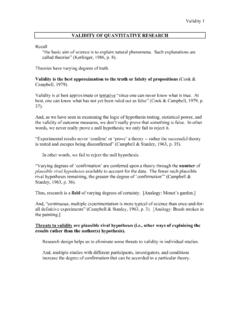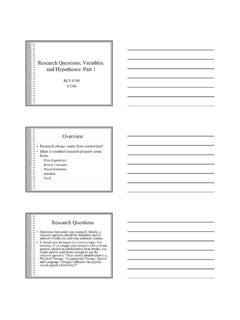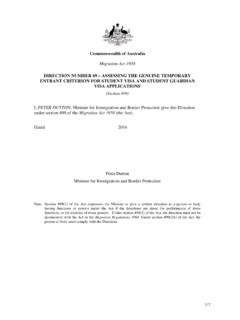Transcription of SINGLE SUBJECT RESEARCH What Are Single-Subject/System ...
1 SINGLE SUBJECT 1 SINGLE SUBJECT RESEARCH What Are SINGLE - SUBJECT /System Designs? SINGLE - SUBJECT designs involve in-depth quantitative study of the response of an individual or a group of individuals to an intervention or the withdrawal of that intervention (Szymanski, 1993). Basically, SINGLE - SUBJECT designs, focus on a SINGLE individual in a RESEARCH sample (Alberto & Troutman, 1990), are the extension of the quasi-experimental studies time-series designs (Wang, 1995) or a variation of the time-series/within-subjects design (Dooley, 1990). The interrupted-time-series design represents the logical extension of the general observation-treatment-observation design (Elmes, Kantowitz, & Roediger, 1992).
2 Definition of Related Terms (Alberto & Troutman, 1990) Variables Dependent Variable (DV): The behavior targeted for change Independent Variable (IV): The treatment or procedure that the experimenter controls the treatment or procedure being used to change behavior o Typically, in SINGLE - SUBJECT studies, the categories of the IV reflect the phases of the treatment or lack of treatment. For example, Baseline, Treatment, No Treatment Baseline, Treatment A, Return to Baseline, Treatment B, Return to Baseline Baseline, Treatment A, Treatment A+B, Treatment A+B+C, Fade Components of SINGLE - SUBJECT Designs Baseline Measures Baseline data are measures of the level of behavior (the DV) as it occurs naturally, before intervention.
3 Baseline data serve two functions: o descriptive function o predictive function Baseline should be stable and baseline trends should be taken into account before intervention. A trend in the data refers to an indication of a distinctive direction in the performance of the behavior. A trend is defined as three successive data points in the same direction. A baseline may show no trend, an increasing trend, or a decreasing trend. (The researcher should initiate intervention on an ascending baseline only if the objective is to decrease the behavior. In contrast, the researcher should initiate intervention on a descending baseline only if the objective is to increase the behavior.)
4 SINGLE SUBJECT 2 Intervention Measures A series of repeated measures of the SUBJECT 's performance under a treatment or intervention condition. The IV (treatment or intervention) is introduced and its effects on the DV (the SUBJECT 's performance) are monitored. Trends in treatment data indicate the effectiveness of the treatment and provide the researcher with guidance in determining the need for changes in intervention procedures. Others Phase: A distinct stage/period of a target behavior ( , baseline phase, treatment/intervention phase, withdrawal phase). Withdrawal: Termination of the administration of an intervention or treatment.
5 Probe: A thorough examination or investigation to the DV ( , the target behavior that you want to improve). Purpose of SINGLE - SUBJECT /System Designs Use it to monitor and evaluate participants responses to the interventions with which they address participants target problems. The strategy is to intensively study one participant system at a time (Grinnell, 1993). Characteristics of SINGLE - SUBJECT /System Designs According to Kratochwill and Williams (1988), SINGLE -case experimental designs have following five characteristics: 1. The researcher repeatedly assesses the DV across various phases of the experiment. Data collected prior to, during, and following the intervention allow measurement of changes on the DV.
6 2. The researcher should have ability to measure variability on SINGLE or multiple dependent measures across time. 3. The researcher usually specifies in great detail the nature of the IV/DV, and the characteristics of the setting, therapist, and participant. Most of these variables are held constant during intervention phases so that functional relationships can be established between the IV and DV. 4. This kind of design can rule out major threats to internal validity through replication of the experimental effects. 5. When applying this kind of design, the researcher has some degree of flexibility to change the nature of the design as data are evaluated across time, or to combine design elements to better rule out various threats to internal validity.
7 Requirements for SINGLE - SUBJECT /System Designs 1. Operational definition of the target behavior must be clearly stated and measurable (Alberto & Troutman, 1990). SINGLE SUBJECT 3 2. outcome measures used to evaluate accomplishment of the objectives must be capable of producing quantitative data that are both valid and reliable. 3. Data must be displayed appropriately. The data obtained from studies conducted following SINGLE -system designs are almost always presented in a simple graphic format (Grinnell, 1993). Two Major Types of SINGLE - SUBJECT /System Designs Depending on the level of sophistication of the RESEARCH design and the validity and reliability of the data collected under it, studies of participant systems based on SINGLE - SUBJECT / SINGLE -system designs can be used to answer two different types of questions (Grinnell, 1993): 1.
8 Evaluative question: Did the participant system improve during the course of the intervention? 2. Experimental question: Did the participant system improve because of intervention? According to Grinnell (1993), the above two types of questions form the basis for categorizing the designs into two major types. However, the following examples are mainly summarized from two books: (a) Alberto & Troutman (1990), and (b) Grinnell (1993). SINGLE -System Evaluative Designs 1. The B Design In the B design, systematic assessment of the outcome measure(s) and implementation of the intervention begin simultaneously. Repeated measurements are taken while the treatment continues, and at the end of the treatment period the data are depicted on a simple graph.
9 Visual inspection of this graph permits one to make inferences as to whether or not the participant s target problem has improved over the treatment period. The B design indicates whether the level of the participant s target problem is changing in the desired direction. 2. The AB Design The AB design requires a valid and reliable outcome measure that is amenable to repeated assessment. However, this design calls for assessing the participant system s target problem several times before the intervention begins. There are two phases: o In the baseline period (A Phase) fluctuations in the participant system s target problem are monitored but no attempt is made to effect any changes in the problem only measuring the target problem.
10 O Interventions are carried out in the B Phase, which follows the baseline period. 3. The Changing criterion Design This design is used to evaluate a gradual and systematic increase or decrease in the client s performance level by changing the criterion for reinforcement in a stepwise fashion. SINGLE SUBJECT 4 This design, much like the AB design, also includes two phases. The intervention phase is divided into subphases. Each subphase requires a closer approximation of the terminal behavior than the previous one. The participant s performance thus moves gradually from the baseline level to the terminal objective. SINGLE -System Experimental Designs Such designs attempt to control for alternative hypotheses by demonstrating that there is more than one coincidence in which treatment began and then the participant system improved or in which treatment is discontinued and the participant deteriorated.








